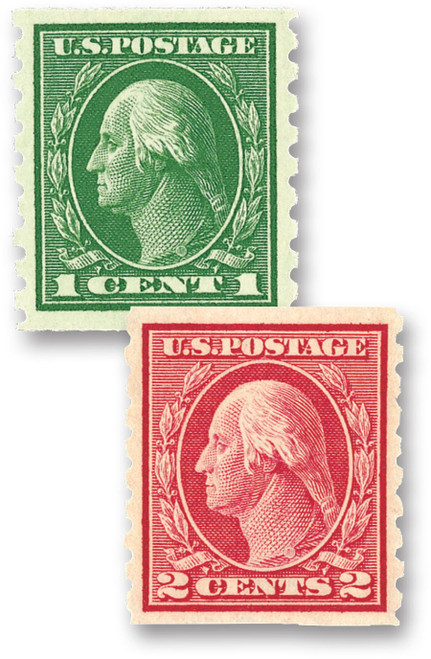
# 412-13 - 1912 Coil Issues, 8 1/2 vertical perf
Are You Missing These 1912 Washington-Franklin Coils?
Single Line Watermark, Perforated 8 ½ Vertically
The Washington-Franklins are among the most fascinating and challenging US stamps to collect. Issued between 1908 and 1922, they encompassed over 200 varieties, five different designs, two paper types, three printing methods, at least 14 perforations, several colors, and 20 denominations.
You can come one step closer to completing your Washington-Franklin collection with this convenient set of two stamps. Each of these stamps was printed on single line watermark paper and perforated 8 ½ vertically.
Stamps Changed to Meet UPU Standards
To avoid confusion among postal clerks, officials decided to picture George Washington on all Series of 1912-14 denominations of 7¢ or lower. Denominations of 8¢ and above pictured Benjamin Franklin.
When the dies for the new series were prepared, all of them had the denominations in words and not numerals. It was pointed out, after the 1¢ and 2¢ stamps had already been issued, that this format did not conform to the Universal Postal Union’s regulations. According to their standards, the denominations were to be in numerals so they could be understood in any language. The printings for the 3¢ through $1 were held up and the plates changed to comply with UPU’s guidelines. Since the one- and two-cent stamps had been released, the decision was made not to change the plates. In 1912, the denominations were finally switched to numerals.
During the years these stamps were produced, the Bureau of Printing and Engraving changed the watermarks, varied the perforations, and experimented with different types of paper. Imperforate stamps, as well as coils and booklets, were also released. The result was the printing of 175 major varieties. Although these stamps look remarkably similar, there are notable philatelic differences. The Postal Department did not regard these differences as significant, and as late as 1925, postal reports listed some issues as “Series 1908.”
Are You Missing These 1912 Washington-Franklin Coils?
Single Line Watermark, Perforated 8 ½ Vertically
The Washington-Franklins are among the most fascinating and challenging US stamps to collect. Issued between 1908 and 1922, they encompassed over 200 varieties, five different designs, two paper types, three printing methods, at least 14 perforations, several colors, and 20 denominations.
You can come one step closer to completing your Washington-Franklin collection with this convenient set of two stamps. Each of these stamps was printed on single line watermark paper and perforated 8 ½ vertically.
Stamps Changed to Meet UPU Standards
To avoid confusion among postal clerks, officials decided to picture George Washington on all Series of 1912-14 denominations of 7¢ or lower. Denominations of 8¢ and above pictured Benjamin Franklin.
When the dies for the new series were prepared, all of them had the denominations in words and not numerals. It was pointed out, after the 1¢ and 2¢ stamps had already been issued, that this format did not conform to the Universal Postal Union’s regulations. According to their standards, the denominations were to be in numerals so they could be understood in any language. The printings for the 3¢ through $1 were held up and the plates changed to comply with UPU’s guidelines. Since the one- and two-cent stamps had been released, the decision was made not to change the plates. In 1912, the denominations were finally switched to numerals.
During the years these stamps were produced, the Bureau of Printing and Engraving changed the watermarks, varied the perforations, and experimented with different types of paper. Imperforate stamps, as well as coils and booklets, were also released. The result was the printing of 175 major varieties. Although these stamps look remarkably similar, there are notable philatelic differences. The Postal Department did not regard these differences as significant, and as late as 1925, postal reports listed some issues as “Series 1908.”




